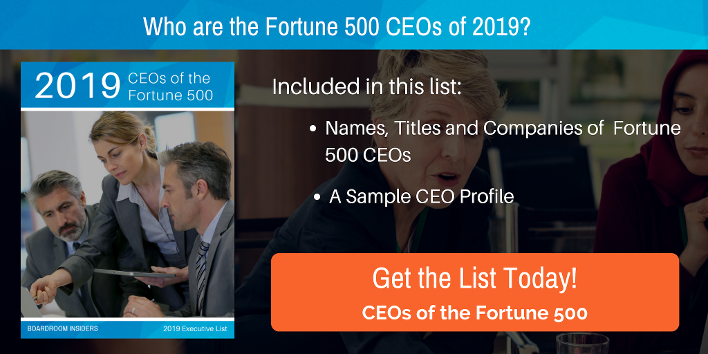.png?width=640&name=Do%20C-Level%20Executives%20Agendas%20Matter_%20(1).png)
A little more than six years ago, my partner Lee Demby wrote that when talking with customers about the value of C-Level executive insights, he sometimes heard, “But we don’t sell to the C-level.”
Why are conversations with the C-Level inevitable and necessary?
Times have changed. Technology vendors have woken up to the reality that C-Level conversations are inevitable and necessary. Why? Because major technology purchases are increasingly tied to corporate-wide, digital transformation efforts, which are largely being driven by C-Level players.
Useful insight can be well used to your advantage.
Not convinced? Let’s look for a moment at Hershey Company. President and CEO Michele Buck told Fortune in October 2017 that she plans to take Hershey beyond chocolate and turn it into an “innovation snacking powerhouse.” She’s open to mergers and acquisitions to accelerate growth into spaces their brands currently can’t travel—and she is driving a focus on collaboration with key brick-and-mortar retailers and established e-commerce players, and leveraging and commercially activating consumer data, using predictive analytics, machine learning, and big data sets to identify candy and snack growth opportunities.

This is useful insight about Hershey that an astute salesperson should be able to use to their advantage. Even if you don’t actually cross paths with Buck and are engaged instead with lower-level executives and middle managers, it would serve you well to understand her agenda and integrate her words into a pitch to your contacts at Hershey.
Here’s another example. James Hackett, Ford Motor Company’s relatively new President and CEO, explained to Fortune that he wants the company to be "fitter," and is slashing costs by $14 billion over five years by investing less in manufacturing and more in electric vehicles, trucks, and SUVs. Hackett outlined a six-point strategy for Ford in October 2017 that calls for cost cuts, shifting budget to more profitable trucks and SUVs, moving some manufacturing to China, simplifying and modernizing factories and model designs, and pushing internet connectivity.
Then there’s Charles Scharf, Chairman and CEO of Bank of New York Mellon Corporation. He told analysts in October 2017 that, “...there is nothing more important than ensuring we have got the best operating environment and core technology platform to build from. It is important that everyone understands that this is a multi-year effort…We have made significant improvements in improving our core platforms, but this is a journey and significant continued investment is necessary…” He told analysts that the bank spends $2 billion annually on technology and will continue to devote “an outsized amount of our resources” to it. He complained about the complexity of the company’s operating environment, wants to drive efficiency and is developing a “multiyear plan to automate much of the manual work that exists today.”
This alone is a bonanza of information for a technology sales executive. Understanding Scharf’s agenda—and how focused he is on technology, with a budget to support it—is extraordinarily useful as you plot your sales strategy.

Like Buck, Hackett, and Scharf, every year C-Level executives issue a handful of business objectives or initiatives that guide all other activities inside their companies or departments. These can be found in C-Suite interviews, speeches, annual reports, analyst calls, and SEC filings. Under the C-Suite's direction, all activity and investment must roll up to these initiatives. If you can show a direct connection between your company’s offering and that agenda, your value proposition stands a stronger chance of being considered, embraced and defended by your customer.
Understand the agenda of your customer's C-Suite executives.
Those well-versed in a customer's C-Suite agenda should be able to answer many of these questions:
- What are their business goals for the year?
- What products/solutions are they most focused on?
- Are they looking to expand internationally or grow domestically?
- Grow organically or through acquisition?
- Cut costs or ratchet up R&D/marketing spend/hiring?
- Are they pro-outsourcing or focused on insourcing?
- What types of partnerships are they seeking?
And if you don't...
Those who haven’t bothered to understand C-Level agendas usually find themselves at a disadvantage. Here are two main issues they often encounter:
- An inability to show how their solution supports the customer’s CXO agenda, resulting in a deal that gets nixed by higher ups who don’t see alignment with corporate priorities.
- The CXO agenda could have served as a rationale for an even broader set of the vendor’s solutions than is being considered—but since they don’t know what the agenda is, they don’t take advantage of the opportunity.
.png?width=600&height=200&name=CXO%20Agendas%20are%20important%20(1).png)
This brings up another potential stumbling block. If you rely on your champion to educate you without doing your own homework, you may be setting yourself up for a fall. It’s surprisingly common for lower-level executives to not have a firm grasp of their own executive team’s big-picture objectives. Taking the initiative to understand the C-Suite’s priorities can help you avoid that—and even help your champion see the bigger picture and look smarter to their boss.
And finally consider this: if you are in the habit of waiting for RFPs to tell you what a company thinks it needs, you’re missing the boat. The smartest and most successful sales organizations aim to get ahead of RFPs by knowing what the company is trying to accomplish and helping them define what they need to do to get there. That kind of initiative and partnership is what will give you an edge over your competition more than anything else.







Share Your Thoughts